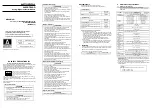
DSP Implementation Guide
370
As you can see, once the output of the final plug-in was connected to the output port, the input-to-output
connection was removed, and you are now listening to the processing chain.
Note:
When sidechain-capable plug-ins are used in a Graph, the sidechain input is exposed as a routing
point
Figure 13.26: Sidechain routing in the Graph
...and takes the place of the “Sidechain Assign” header element in the plug-in UI.
The graph is continuously modifiable with or without audio running. You can drag the plug-ins around as
you like, and you can add new plug-ins, even while you are processing audio with the existing graph. You
can make and break connections as you please.
Remember:
⌃-click
(Control)-click on the input port to remove a connection
or hit Bypass to remove the
graph from the signal path.
There is no routing delay within the plug-in graph. So if you make mults with different plug-in paths on each
side of the mult, the two paths will remain time-aligned. This allows you to configure parallel processing
paths without the annoying (and virtually impossible) task of manually time-aligning the parallel paths.
At this point, you will want to be able to control each plug-in‘s parameters. Double-click on any plug-in
to view its UI as described
.
for the full breakdown of every available Graph instrument.
Содержание 3d Upgrade Board Set
Страница 1: ...Metric Halo 3d Users Guide...
Страница 111: ...2882 Specifications 171...
Страница 183: ...Installation and Registration 183 Figure 9 7 Security Privacy Privacy tab Allow MIOConsole3d access to Microphone...
Страница 456: ...The DSP Toolchest 456 Parameters F 10 20k Sets the crossover frequency in Hz of the bandsplit...
















































